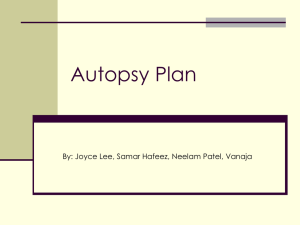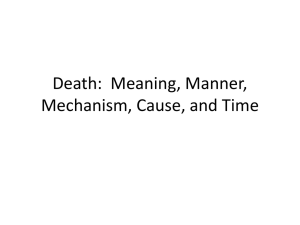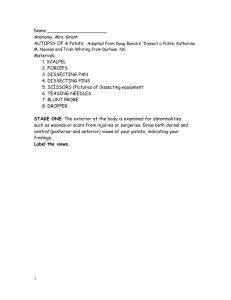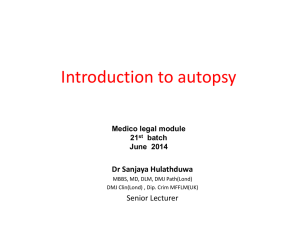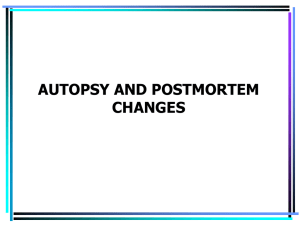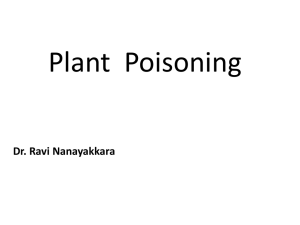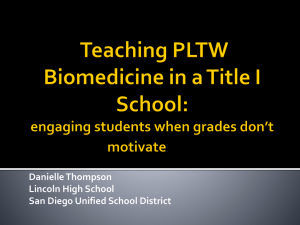2006
advertisement
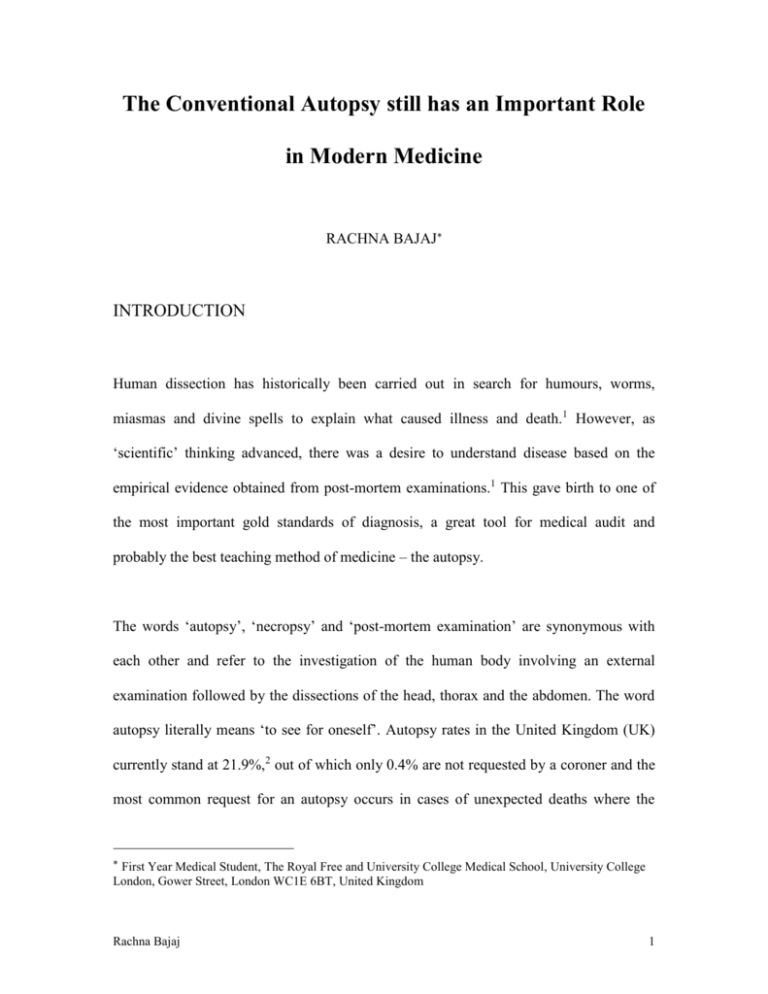
The Conventional Autopsy still has an Important Role in Modern Medicine RACHNA BAJAJ INTRODUCTION Human dissection has historically been carried out in search for humours, worms, miasmas and divine spells to explain what caused illness and death.1 However, as ‘scientific’ thinking advanced, there was a desire to understand disease based on the empirical evidence obtained from post-mortem examinations.1 This gave birth to one of the most important gold standards of diagnosis, a great tool for medical audit and probably the best teaching method of medicine – the autopsy. The words ‘autopsy’, ‘necropsy’ and ‘post-mortem examination’ are synonymous with each other and refer to the investigation of the human body involving an external examination followed by the dissections of the head, thorax and the abdomen. The word autopsy literally means ‘to see for oneself’. Autopsy rates in the United Kingdom (UK) currently stand at 21.9%,2 out of which only 0.4% are not requested by a coroner and the most common request for an autopsy occurs in cases of unexpected deaths where the First Year Medical Student, The Royal Free and University College Medical School, University College London, Gower Street, London WC1E 6BT, United Kingdom Rachna Bajaj 1 cause is not apparent.34 Autopsies are also carried out for determination of manner of death, evaluation of ante-mortem and post-mortem diagnosis, epidemiological purposes, survey outbreaks, medical audit, research, teaching, forensic purposes and to enlighten/reassure families or inform then of hereditary diseases.5 Despite the well-recognised importance of autopsies in twenty-first century medicine, there has been a huge decline in autopsy rates across the world, causing concern amongst the medical community. Factors that have contributed to the decline include distaste of the procedure in both the physicians and the relatives, lack of financial incentives, increased faith in imaging technologies, fear of litigation, lack of importance of the autopsies in the teaching curriculum and poor communication skills on part of the requesting physicians.6,7 Moreover, even if the clinicians do request for an autopsy, many do not receive the autopsy report or that there are several delays in receiving the report.8 For example, in a study conducted by Whitty9 et al in the north east Thames region, it was found that autopsy results were conveyed to general practitioners in only 47% of the cases. This has caused an immense loss of learning opportunity and fostered an attitude of apathy in physicians towards autopsy as a tool for learning. Organ retention scandals at Alders Hey Hospital10 and the Bristol Royal Infirmary11 have been implicated as contributing causes of the autopsy’s decline in the UK. This essay henceforth aims to demonstrate the importance of the conventional autopsy to modern medicine and will then discuss some methods of its revival in current medical practice. It will also address the challenges posed to the conventional autopsy by modern Rachna Bajaj 2 The Conventional Autopsy still has an Important Role in Modern Medicine techniques such as endoscopy, Magnetic Resonance Imaging (MRI), Computed Tomography (CT) scans and angiography and highlight the importance of necropsy in clinical discovery. THE VALUE OF THE CONVENTIONAL AUTOPSY IN MODERN CLINICAL PRACTICE Teaching As Moore and Dalley12, authors of the highly acclaimed anatomy text, ‘Clinically Oriented Anatomy’, describe, ‘ You will remember some of what you hear, much of what you read, more of what you see and almost all of what you experience and understand fully’. This is essentially the main reason why autopsies are such a powerful tool in medical teaching. They allow a student to experience the information in a textbook.13 Sir William Osler, a renowned physician of the 19th century, placed the autopsy at the centre-stage of medical education.14 In fact, despite being a busy physician he carried out more than one thousand autopsies and used his findings to explain the pathologic basis of disease in his book called ‘The Principles and Practice of Medicine’.14 Osler’s textbook reflects the intimate link between autopsies and medical knowledge. A strong grasp of pathology, together with the ability to learn from the wrong ante-mortem diagnosis lays the foundation to make a great diagnostician, he believed.14 Rachna Bajaj 3 The Conventional Autopsy still has an Important Role in Modern Medicine Hill and Anderson15 have also outlined the value of the autopsy to students. Autopsies allow students to grasp pathology in clinical contexts.15 The knowledge of the physiological processes in disease states is better illustrated with autopsies.15 Necropsy sessions also provide the opportunities to learn anatomy and sharpen skills of observation.15 The sessions are useful in impressing upon students that many conditions often remain undetected despite extensive diagnostic tests and that multiple pathologies add to diagnostic difficulty.16 This may familiarise students with uncertainty created by imperfect diagnostic procedures.16 The autopsy sessions provide opportunities to discuss subjects like death certification, forensic pathology, appropriate attitudes towards deaths and communication skills essential for giving bad news or seeking consent for autopsy.7,17 These skills are enhanced in a realistic, interactive environment rather than solely from an inanimate medical textbook.15-17 Not surprisingly, medical students who took part in the survey conducted by University of Manchester found that autopsies are valuable in medical education even though about 17.6% disliked the offensiveness of the procedure18. However, since the autopsy rates even in teaching hospitals in the UK are below 5%,19 there are too few opportunities for medical students to gain reasonably from the autopsy experience.15 Moreover it has been reported that there is not sufficient time to include autopsies in the teaching timetable even though curriculum planners consider autopsies to be valuable to medical education.15 Clinical Audit Rachna Bajaj 4 The Conventional Autopsy still has an Important Role in Modern Medicine A lot of literature advocates the use of autopsies for the purposes of clinical audit even though many clinicians consider the autopsy worthless in providing novel information relevant to the advancement of medicine.20 Audit in medical contexts, as defined by the Royal College of Pathologists (RCP), is a process of methodically and critically appraising the quality of patient care.21 This involves assessing diagnostic procedures, treatments, resource utilization and clinical outcomes.21 The purpose of audit is to identify weaknesses in the system and recommend actions to overcome them.21 For clinical audit to be meaningful, it is essential that autopsy rates, the quality of reporting and conducting the autopsy are high.20,21 Only autopsies involve the thorough assessment of all clinical-pathologic aspects. Clinicians on the other hand diagnose only the conditions that they suspect. Hence, autopsies are considered useful in verifying the accuracy of ante-mortem diagnosis, death certificates, examining suitability of medical treatment and investigating perioperative deaths.20 Verification of ante-mortem diagnosis A discrepancy rate as high as 40%5,22 approximately exists between the ante-mortem and the post-mortem diagnosis. An investigation by University of Pittsburgh23 revealed that the discordance rates were 35% in 1938,24 39% in 1959,25 43% in 1974,26 and 47% in 198327. This seems to indicate that there has been no progress despite the great leaps in diagnostic technology over the decades. Moreover, a sizable percentage of the diagnostic Rachna Bajaj 5 The Conventional Autopsy still has an Important Role in Modern Medicine errors fall into the Goldman class I and II categories (7-13% and 15-25% respectively)28, which are defined below along with the Goldman class III and IV categories. Box 1 – The box defines the classification created by Goldman29 pertaining to diagnostic errors obtained from the comparison between ante-mortem and post-mortem diagnosis. Class I - a serious pathology, which if diagnosed while the patient was alive could have led to cure and thereby possibly have extended survival Class II – a serious disease which even if diagnosed in life would not have influenced the treatment or care plan. Class III – non life threatening diagnosis linked to an incurable disease but not immediately responsible for death Class IV – other types of non life threatening diagnosis In the past, the discordance rates between post-mortem and ante-mortem diagnosis were as high as 77% for spinal tuberculosis, 61% of cirrhosis and 26% for lobar pneumonia. 30 These results however were attributed to limitations in the diagnostic methodology instead of incorrect evaluation by the responsible clinicians. Eventually, diseases such as spinal tuberculosis became rare as medicine advanced.20 Despite the progress, studies have consistently shown that the discrepancy rates remain significant. 20 Goldman29,31 et al evaluated the value of autopsies in the 1960s, 1970s and the 1980s, and found that approximately 10% of the 100 randomly chosen autopsies in each of these decades revealed a serious diagnosis. The study also revealed that an additional 12% of the autopsies revealed class II diagnostic errors. It was concluded that many cases Rachna Bajaj 6 The Conventional Autopsy still has an Important Role in Modern Medicine remained undiagnosed despite the high dependence on CT scans, ultrasound and radionucleotide scans around 1980s. It is believed by some doctors that these discrepancy rates could be an overestimate because patients were selected for autopsies due to uncertainty about the ante-mortem diagnosis.20 Moreover Goldman et al published their study 1983, which will be considered outdated by today’s standards. Are the results still valid today? Kaveh32 et al who published their study 20 years later have estimated that a major error rate and a class I error rate in a modern US institution could vary from 8.4% to 24.4% and 4.1% to 6.7% respectively. These figures indicate ranges which correspond to autopsy rates ranging from 100% (rate at which there is no clinical selection) to 5% (the US national average). The need to establish an exact cause of death of their newborn is highly important for parents who will be able to use this information to plan future pregnancies and take certain precautions. Gordjin33 et al report that the perinatal autopsy is highly valuable as it reveals additional findings or detects the wrong clinical diagnosis in 22% to 76% of the cases. Studies have also shown that the accuracy of clinical diagnosis does not improve even if clinicians feel certain about their diagnosis. For example, in Edinburgh, clinicians were shown to be wrong 1 out of every 4 times even when they felt ‘fairly certain’ about their diagnosis.34 The discrepancy rates also did not improve even when the length of stay in hospital was increased.35 Rachna Bajaj 7 The Conventional Autopsy still has an Important Role in Modern Medicine Even though most of the literature highlights the usefulness of necropsies for verification of clinical diagnosis, Forsythe36 et al have published a study that contrasts this widely held belief. In their study they autopsied 102 of their patients who died in their trauma centre. Out of these patients none was observed to have a class I error and there was only 1 case in which an unavoidable technical error occurred. Hence it was concluded that autopsies were not useful for adding to the trauma peer reviewed quality assurance process. A serious setback that the conventional autopsy faces is that at present no study has been able to correlate high autopsy rates with a decreased discrepancy rate. 21,37 Despite this glaring fact, discrepancy rates are considered an important measure of quality care. Lassiue38 et al and the RCP21 believe that if this link is proved, the importance of autopsies to modern medical practice will be irrefutable. For verification of death certificates Many countries issue death certificates without the need of an autopsy. This may lead to significant errors in epidemiological statistics which could have far-reaching impacts on resource allocation, public health policies, and the ability to monitor outbreaks and detect environmental/occupational hazards. For instance, it has been reported that death certificates in the USA are inaccurate in 25 to 56% of the cases.20 In the UK, this figure is estimated to be around 30%.20 Rachna Bajaj 8 The Conventional Autopsy still has an Important Role in Modern Medicine Investigating perioperative deaths The importance of necropsies with regards to the investigation of perioperative deaths was emphasized in the report published in 1990 by the National Confidential Enquiry into Perioperative Deaths (NCEPOD).8,20 It was commented that the low autopsy rates were to be ‘deplored’ because the autopsy was a ‘useful investigation’ for numerous audit purposes of which NCEPOD was only one of a kind.8 Recommendations were made to increase the quality of information stored in medical records and increase post-mortem rates.8 Consultants were urged to become keen in seeking consent from families about the autopsy because it was discovered that in only 20 out of 417 autopsies studied20, were the consultant personally involved. It was also noted during the enquiry that in less than half of all autopsy cases were the surgeons informed of the autopsy date and time20. Assessing the suitability of medical treatment Underwood20 reports that the cause of death in many cancer patients is often attributed to their illness rather than to the damaging effects of the cancer treatment. He explains that pathologists sometimes face situations in which the patient was given strong cancer treatment and yet there was actually no evidence of a tumour being present in the body when it was autopsied. He argues that it is essential to assess if toxic treatments have been appropriately applied especially when the consequence of these treatments can be fatal. Rachna Bajaj 9 The Conventional Autopsy still has an Important Role in Modern Medicine THE CONVENTIONAL AUTOPSY VERSUS TECHNOLOGY CT scans and MRI It has been widely debated that advances in diagnostic technology have rendered the conventional autopsy redundant especially when technology can provide us most of the answers that we need. For example, the conventional autopsy has been challenged by the advent of virtopsy (image-guided autopsy).39 This is a technique which involves the use of CT scans, MRIs and minimally invasive biopsy to investigate the cause of death. The virtopsy has the advantage of being a quicker and less invasive method in comparison to the conventional autopsy.39,44 It also proves useful in circumstances where relatives are unable to consent to a full autopsy due to religious/personal reasons. 39,44 It has been argued that because it has been possible to have a high degree of resolution with a three dimensional reconstruction, virtopsy can eventually replace the conventional autopsy.39 This belief however seems to be questioned in a study40 comparing the use of MRI autopsy with the conventional autopsy. In this study, 10 MRI autopsies were performed in cases of non-forensic sudden unexpected adult deaths. Four radiologists were required to report their findings independently on all 10 cases. In only one case out of the ten were all the radiologists able to state the same cause of death as that discovered by the conventional autopsy. In four cases, none of the radiologists were able to point the correct cause of death even though they discovered important features. A problem in distinguishing between the post-mortem clots of thrombus and oedema from Rachna Bajaj 10 The Conventional Autopsy still has an Important Role in Modern Medicine inflammatory exudates was reported. It was hence concluded that it was better to carry out the imaging techniques whilst the patient was alive as this was more cost effective.41 Investigations performed by Patriquin42 et al support the conclusions of the abovementioned study. In a research done at Nottingham University, 70 patients were clinically diagnosed using MRI to have suffered anterior circulation stroke syndrome.43 However, when autopsies were conducted only 49 of the 70 patients were correctly diagnosed, whereas 6 were misdiagnosed and 15 were misclassified. The implications of these findings are that errors due to misdiagnosis will not have been taken into account in clinical trials and the results could be confounded. This will mean that the therapy for strokes will be misapplied in patients who have been misdiagnosed. In another similar pilot study as described above, the conclusions were that radiological investigations provided certain details which were not found out during the autopsy and the autopsy provided certain details that were not apparent from radiological investigations.44 This study henceforth advocated that more research needs to be done to improve imaging techniques for pathology purposes, evaluate the sensitivity and specificity and also assess cost effectiveness. Research carried out by Whitby45 et al, Woodward46 and Brookes47 also report findings that propose the use of MRIs as substitutes for the conventional autopsy. Endoscopy Rachna Bajaj 11 The Conventional Autopsy still has an Important Role in Modern Medicine Laparoscopic autopsy is also challenging the place of the conventional autopsy in modern medical practice.48 The sensitivity and the specificity of laparoscopic autopsy is 91% and 94% respectively for the diagnosis of intra-abdominal lesions.49 This technique allows one to accurately map certain types of wounds that lack sharpness and are deep, and thereby opening new possibilities in the field on forensic medicine.48,49 Thoracoscopy also offers alternatives to investigate bleeding into the pleural cavity and assess injuries of the diaphragm. Like virtopsy these techniques also have the advantages of being less invasive and can circumvent the issues of consent and religious reservations. Needle Necropsy Another technique with has attempted to replace the conventional autopsy is the needle necropsy. However this approach has limitations because some organs and lesions are relatively inaccessible.50,51 Studies have reported that the sensitivity of needle necropsy compared with the conventional autopsy could be 67%, 48% and 43%.52,53,54 Hence attempts have been made to perfect this technique. Farina51 et al have considered the use of ultrasonography, also known as echopsy, to improve the way samples are collected. Despite the more advanced manner of sample collection, only 83% concordance rate was observed when measured against the conventional autopsy. The technique is of limited value in the detection of pulmonary thromboembolism, diseases of heart valves and small carcinomas.51 The advantage of ultrasonography combined with needle necropsy however is that it is cheap, easy to perform and more acceptable to relatives. Perhaps it Rachna Bajaj 12 The Conventional Autopsy still has an Important Role in Modern Medicine may also prove to be a more suitable alternative with the new threat from infectious diseases.51 This approach is suitable for discovering diseases not diagnosed in life as well unlike MRIs and CT scans.51 Post-mortem Coronary Angiography Post-mortem coronary angiography is regarded to be superior to the conventional autopsy as it is better able to determine the extent of deposition of fatty plaques in the coronary artery.55 This is because in conventional autopsy, stenosis of the coronary arteries is determined after sectioning them.50 Errors are introduced depending on the type of sectioning chosen. High calcification of the arteries will cause these errors to be large.50 Moreover, the pathologist will not be able to re-examine the heart after the post-mortem unless the whole of the coronary artery is preserved for histological purposes.50 Postmortem angiography conversely is a more precise and reproducible technique for assessing the degree of stenosis and detecting acute thrombotic coronary occlusion. Moreover, post-mortem clots do not pose a problem as they hardly ever lodge in coronary arteries. Weman56 reports that the sensitivity was 100% for discovering anastomotic and graphed stenosis. Indeed, it was difficult to observe these findings using the conventional autopsy. THE AUTOPSY AND DISCOVERY Specific diseases where autopsies have proven to be particularly useful in the elucidation of diagnosis are metastatic neoplasms31 and Alzheimer’s disease. Burton22,31 Rachna Bajaj et al 13 The Conventional Autopsy still has an Important Role in Modern Medicine pointed out that more than three out of four of the liver cancers are revealed only at the autopsies. The diagnosis of Alzheimer’s disease is also only confirmed conclusively after the necropsy of the brain. This is because the clinical method of diagnosing Alzheimer’s involves excluding all other possibilities for the symptoms observed. The autopsy has also enabled the discovery of many new diseases ever since it has been used for medical purposes. Examples include the West Nile virus and Creutz-felt Jacob Disease (CJD) and Alzheimer’s disease.57 Autopsies are also important for research and development of surgical techniques. The technique of open heart surgery for example was perfected with the help of autopsies.57 In the future, Goldman58 believes that the autopsy will remain an important tool to diagnose the diseases of old age. It is possible that more new and exotic diseases will be discovered as the life expectancies of populations increase. A relatively reasonable rate of autopsies is required in the future if medical knowledge and advancement is desired. REVIVAL The NCEPOD inquiry recommends that communication between clinicians and pathologists needs improvement and the autopsy report needs to be promptly sent to the relevant clinicians. Smith and Zumwalt59 recommend that a video should be created for relatives to emphasize the value of the autopsy. Nurses and clergy could be deployed to seek consent instead of clinicians as this has proven to increase rates. Roberts60 recommends that more clinically relevant information should be provided in autopsy Rachna Bajaj 14 The Conventional Autopsy still has an Important Role in Modern Medicine reports to generate an interest for autopsies in clinicians. Haque61 et al suggest that the fears of legal repercussions need to be allayed if it is hoped that rates should rise again. Seeking the support of the hospital administrations61, arranging financial incentives62, setting compulsory government targets and improving public acceptance63 may help autopsy rates to climb again. It has also been suggested that students may be allowed to learn from coroner’s autopsies in face of declining hospital autopsies.64 REFERENCES 1 Cotton DWK. Historical Introduction. In: Cotton DWK, Cross SS, eds. The hospital autopsy. Oxford: Butterworth Heinnemann, 1993:p. 1-7 2 Office for National Statistics. Mortality Statistics Series DH2 no.29. Review of the Registrar General on deaths by cause, sex and age, in England and Wales, 2002. London: HMSO; 2003. 3 Delaney RJ, Gallagher PJ. The value of postmortem examinations after surgery. Ann R Coll Surg Engl (Suppl) 2005; 87: 106-109 4 Lund JN, Tierney GM. Hospital autopsy: standardised questionnaire survey to determine junior doctors' perceptions. BMJ 2001;323:21-22 Available from:http://bmj.bmjjournals.com/cgi/content/full/323/7303/21 5 Lundberg GD. Low-Tech Autopsies in the Era of High-Tech Medicine: Continued Value for Quality Assurance and Patient Safety. JAMA 1998 280: 1273-1274. 6 Berger F. Clinical diagnosis and the function of necropsy. J R Soc Med 2000 93: 662a 7 Charlton R. Autopsy and medical education: a review. J R Soc Med. 1994 Apr;87(4):232-6. 8 Carr NJ, Burke MM, Corbishley CM, Suarez V, McCarthy KP. The autopsy: lessons from the National Confidential Enquiry into Perioperative Deaths. J R Soc Med. 2002 Jul;95(7):328-30. 9 Whitty P, Parker C, Pietro-Ramos F, Al Kharusi S. Communication of results of necropsies in north east Thames region. BMJ 1991;303:1244-6. 10 Department of Health, 2001. The Royal Liverpool Children’s Inquiry: Summary and Recommendations [www.rlcinquiry.org.uk] Rachna Bajaj 15 The Conventional Autopsy still has an Important Role in Modern Medicine 11 Bristol Royal Infirmary Inquiry, 2001. Learning from Bristol: the Report of the Public Inquiry into Children’s Heart Surgery at the Bristol Royal Infirmary 1984–1995 [www.bristol-inquiry.org.uk] 12 Moore HL, Dalley AF. Clinically Oriented Anatomy. 5th edition. Philadelphia: Lippincott Williams & Wilkins, 2006. 13 Cross SS. Clinical demonstration, autopsy report and teaching. In: Cotton DWK, Cross SS, eds. The hospital autopsy. Oxford: Butterworth Heinnemann, 1993:p. 131-133 14 Rodin AE. Osler's Autopsies: Their Nature and Utilization. Medical History 17 (1973) 37-48. 15 Hill RB, Anderson RE. The uses and value of autopsy in medical education as seen by pathology educators. Acad Med 1991;66:97-100. 16 O'Grady G. Death of the teaching autopsy. BMJ 2003;327:802-803 17 Galloway M. The role of the autopsy in medical education. Hosp Med 1999;60:756-8. 18 Benbow EW. Medical students’ views on necropsies. J Clin Pathol1990;43:969-76. 19 Underwood JCE. A matter of life and death. NHS Magazine. 2003 February [cited 21June 2006] Available from: http://www.nhs.uk/nhsmagazine/archive/feb03/opinion.asp 20 Underwood JCE. Autopsies and the audit. In: Cotton DWK, Cross SS, eds. The hospital autopsy. Oxford: Butterworth Heinnemann, 1993:p. 163-172 21 Joint Working Party of representatives from the Royal College of Pathologists, Royal College of Physicians of London and the Royal College of Surgeons. Report of the Joint Working Party on the Autopsy and Audit. London: Royal College of Pathologists, 1991. 22 Burton EC, Troxclair DA, Newman WP III. Autopsy diagnoses of malignant neoplasms. How often are clinical diagnoses incorrect? JAMA 1998;280:1245-8. 23 Nichols L, Aronica P, Babe C. Are autopsies obsolete? Am J Clin Pathol. 1998 Aug;110(2):210-8. 24 Bean WB. Infarction of the heart. Ann Intern Med. 1938;11:2086-2108. 25 Johnson WJ, Achor RWP, Burcell RP et al. Unrecognised myocardial infarction. Arch Intern Med. 1959;103:252-261. 26 Britton M. Diagnostic errors discovered at autopsy. Acta Med Scand. 1974;196: 203-210. 27 Zarling EG, Sexton H, Milnor PJr. Failure to diagnose acute myocardial infarction. JAMA. 1983;250:1177-1181. Rachna Bajaj 16 The Conventional Autopsy still has an Important Role in Modern Medicine 28 Coradazzi AL, Morganti AL, Montenegro MR. Discrepancies between clinical diagnoses and autopsy findings. Braz J Med Biol Res. 2003 Mar;36(3):385-91. Epub 2003 Mar 7. 29 Goldman L, Sayson R, Robbins S, Cohn LH, Bettmann M, Weisberg M. The value of the autopsy in three medical eras. N Engl J Med 1983;308:1000-5. 30 Cabot RC. Diagnostic pitfalls identified during a study of 3000 autopsies. Journal of the American Medical Association. 1912;59:2295-2298. 31 Frühbeck G. Death of the teaching autopsy: Advances in technology have not reduced the value of the autopsy. BMJ 2004;328:165-166. 32 Kaveh G. Shojania; Elizabeth C. Burton; Kathryn M. McDonald; Lee Goldman. Changes in Rates of Autopsy-Detected Diagnostic Errors Over Time: A Systematic Review. JAMA 2003 289: 2849-2856. 33 Gordijn SJ, Erwich JJ, Khong TY. Value of the perinatal autopsy: critique. Pediatr Dev Pathol. 2002 Sep-Oct;5(5):480-8. Epub 2002 Sep 4. 34 Baron JH. Clinical diagnosis and the function of necropsy. J R Soc Med 2000; 93: 463-6 35 Cameroon HM, McMooggan E and Watson H. Necropsy: a yardstick for clinical diagnosis. BMJ 1980;281:985-988. 36 Forsythe RM, Livingston DH, Lavery RF, Mosenthal AC, Hauser CJ. Autopsies in trauma do not add to peer review or quality assurance. J Trauma. 2002 Aug;53(2):321-5. 37 Battle RM, Pathak D, Humble CG, Key CR, Vanatta PR, Hill RB, Anderson RE. Factors influencing discrepancies between premortem and postmortem diagnoses. JAMA 1987;258:339-344. 38 Laissue JA, Altermatt HA, Gebbers J-O, Truniger B. Quality assessment program on the autopsy service. Am J Clin Pathol 1986;87:788-789. 39 Lavis R. Response to: The value of postmortem examinations after surgery. Ann R Coll Surg Engl (Suppl) 2005; 87: 106-109 40 Roberts IS, Benbow EW, Bisset R, Jenkins JP, Lee SH, Reid H, Jackson A. Accuracy of MRI in determining cause of sudden death in adults: comparison with conventional autopsy. Histopathology 2003; 42: 424-430. 41 Delaney RJ, Gallagher PJ. Original authors' response to letter by Lavis: The value of postmortem examinations after surgery. Ann R Coll Surg Engl (Suppl) 2005; 87: 106-109 Rachna Bajaj 17 The Conventional Autopsy still has an Important Role in Modern Medicine 42 Patriquin L , Kassarjian A, O’Brien M, et al. Postmortem whole-body magnetic resonance imaging as an adjuct to autopsy: preliminary clinical experience. J Magn Reson Imaging 2001;13:277–87. 43 Allder SJ, Moody AR, Martel AL, Morgan PS, Delay GS, Gladman JR, Fentem P, Lennox GG. Limitations of clinical diagnosis in acute stroke. Lancet. 1999 Oct 30;354(9189):1523. 44 Lechner M, Weiss KL, Revelo P, Stemmerman G, Pesce A, Wissman R et al. Virtual Autopsy: A Pilot Study. Available at: http://www.med.uc.edu/meded/summer/PastAbstracts/lechnerm.pdf [Access Date: 21 June 2006] 45 Whitby EH, Paley MN, Cohen M, Griffiths PD. Postmortem MR imaging of the fetus: An adjunct or a replacement for conventional autopsy? Semin Fetal Neonatal Med. 2005 Oct;10(5):475-83. 46 Woodward PJ, Sohaey R, Harris DP, et al. Postmortem fetal MR imaging: comparison with findings at autopsy. AJR Am J Roentgenol 1997;168:41–6. 47 Brookes JAS, Deng J, Wilkinson ID, et al. Three-dimensional imaging of the postmortem fetus by MRI: early experience. Fetal Diagn Ther 1999;14:166–71. 48 Catheline JM, Turner R, Guettier C, Champault G. Autopsy can be performed laparoscopically. Surg Endosc.1999 Nov;13(11):1163-4. 49 Avrahami R, Watemberg S, Hiss Y, Deutsch AA. Laparoscopic vs conventional autopsy: a promising perspective. Arch Surg 1995;130: 407–409. 50 Benbow EW, Roberts ISD. The autopsy: complete or not complete? Histopathology 42 (5), 417-423. 51 Farina J, Millana C, Fdez-Acenero MJ, Furio V, Aragoncillo P, Martin VG, Buencuerpo J. Ultrasonographic autopsy (echopsy): a new autopsy technique. Virchows Arch. 2002 Jun;440(6):635-9. Epub 2002 Jan 31. 52 Foroudi F, Cheung K, Duflou J. A comparison of needle biopsy postmortem with the conventional autopsy. Pathology 1995;27:79–82 53 Huston BM, Malouf NN, Azar HA. Percutaneous needle autopsy sampling. Mod Pathol 1996; 9:1101– 1107 54 West M, Chomet B. An evaluation of needle necropsies. .Am J Med Sci 1957;234:554–560 55 Thomas AC, Davies MJ. Post-mortem investigation and quantification of coronary artery disease. Histopathology 1985; 9; 959–976. Rachna Bajaj 18 The Conventional Autopsy still has an Important Role in Modern Medicine 56 Weman SM, Salminen US, Penttila A et al. Post-mortem cast angiography in the diagnostics of graft complications in patients with fatal outcome following coronary artery bypass grafting (CABG). Int. J. Legal Med. 1999; 112; 107–114. 57 Dobbs D. Buried Answers. The New York Times. Published April 24, 2005. Available at : http://www.nytimes.com/2005/04/24/magazine/24AUTOPSY.html?ex=1150948800&en=e416130c13a574 8a&ei=5070 [Access date: 21 June 2005] 58 Goldman L. Diagnostic advances v the value of the autopsy. 1912-1980. Arch Pathol Lab Med. 1984 Jun;108(6):501-5. 59 Smith RD, Zumwalt RE. One department's experience with increasing the autopsy rate. Arch Pathol Lab Med. 1984 Jun;108(6):455-7. 60 Roberts WC. The autopsy: its decline and a suggestion for its revival. N Engl J Med. 1978 Aug 17;299(7):332-8. 61 Haque AK, Patterson RC, Grafe MR. High autopsy rates at a university medical center. What has gone right? Arch Pathol Lab Med. 1996 Aug;120(8):727-32. 62 Alcolado JC. Death of the teaching autopsy: Hospital and coroners' postmortem examinations are different, not least in payment. BMJ 2004;328:165 63 Twisselmann B. Death of the teaching autopsy: Summary of responses. BMJ 2004;328:167 64 Beh PSL. Death of the teaching autopsy: In Hong Kong teaching autopsies have been championed in public mortuaries. BMJ 2004;328:166 Rachna Bajaj 19


